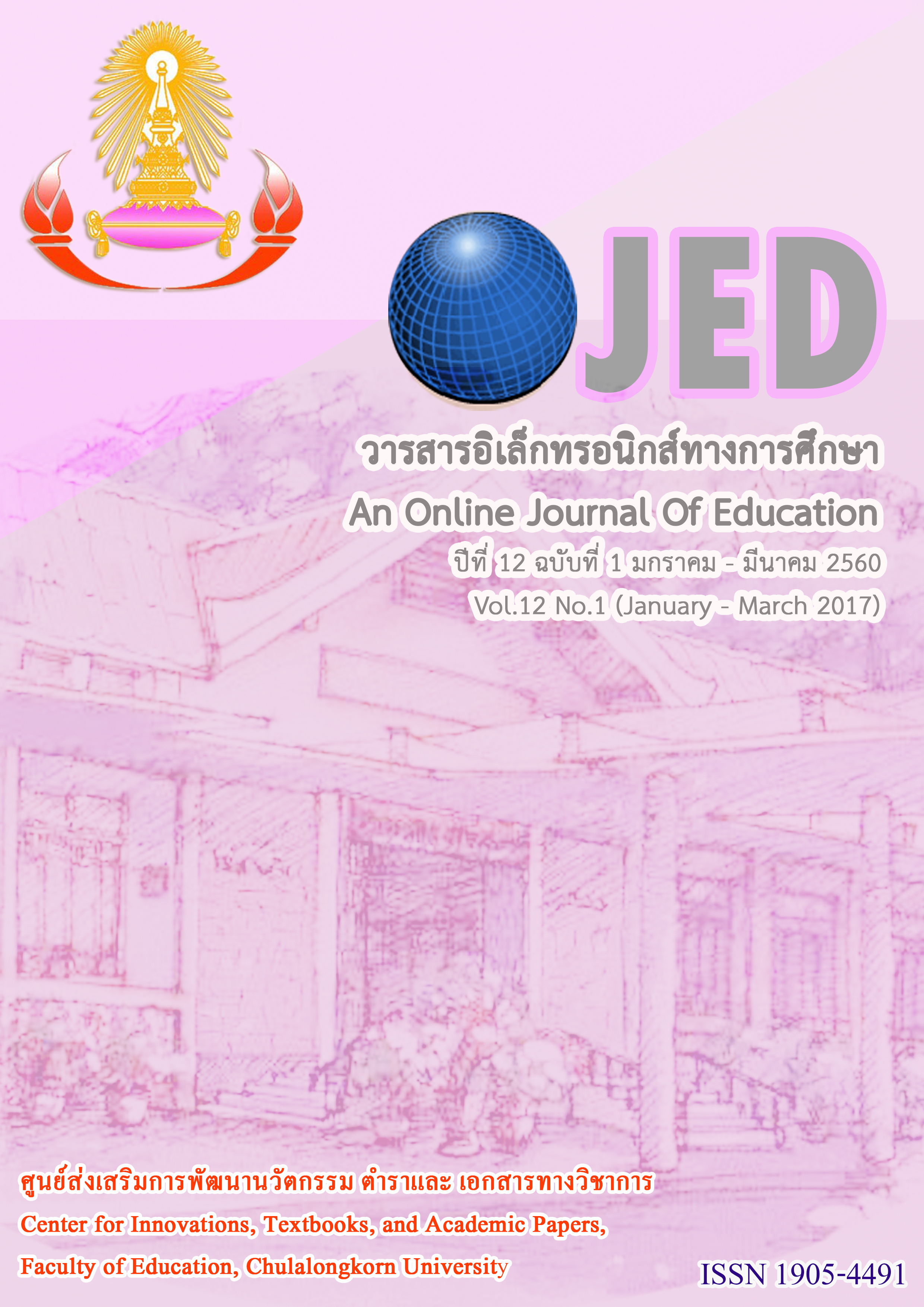ความพึงพอใจและความเข้าใจด้านจังหวะของนักเรียนวงโยธวาทิตระดับประถมศึกษาหลังจากการร่วมกิจกรรมตามแนวคิดคาร์ล ออร์ฟ
Keywords:
วงโยธวาทิต, ประถมศึกษา, คาร์ล ออร์ฟ, ค่าของตัวโน้ต, Marching Band, Elementary, Carl Orff, Note ValueAbstract
การวิจัยในครั้งนี้มีวัตถุประสงค์คือ 1) เพื่อศึกษาความพึงพอใจของนักเรียนวงโยธวาทิตระดับประถมศึกษา ที่มีต่อกิจกรรมตามแนวคิดคาร์ล ออร์ฟ 2) เพื่อศึกษาผลสัมฤทธิ์ของการใช้กิจกรรมตามแนวคิดคาร์ล ออร์ฟ ในการพัฒนาความเข้าใจด้านจังหวะของนักเรียนวงโยธวาทิตระดับชั้นประถมศึกษา เป็นวิจัยกึ่งทดลอง มีนักเรียนวงโยธวาทิต โรงเรียนสาธิตจุฬาลงกรณ์มหาวิทยาลัย ฝ่ายประถม ที่กำลังศึกษาในระดับชั้นประถมศึกษาปีที่ 4-6 ปีการศึกษา 2559 ซึ่งมีประสบการณ์การเล่นดนตรีในวงโยธวาทิตมาไม่น้อยกว่า 1 ปี จำนวน 11 คน เป็นผู้ให้ข้อมูลสำคัญ (Purposive Selection) ผู้วิจัยทำการทดสอบก่อนการทดลองและทดสอบหลังการทดลอง และสำรวจความพึงพอใจของการใช้กิจกรรมจากแบบสอบถามและสัมภาษณ์ ผลการวิจัยพบว่า 1) คะแนนความพึงพอใจของนักเรียนมีค่าเฉลี่ยทั้งหมดอยู่ที่ 3.55 อยู่ในระดับที่ค่อนข้างพอใจมาก ซึ่งนักเรียนแสดงความคิดเห็นว่า กิจกรรมตามแนวคิดคาร์ล ออร์ฟ มีความแปลกใหม่ มีความน่าสนใจกว่าการเรียนดนตรีหรือการซ้อมดนตรีแบบเดิม ๆ ที่เคยเรียนมาและสามารถทำให้นักเรียนเข้าใจจังหวะในรูปแบบของค่าโน้ตตัวดำและเขบ็ตหนึ่งชั้นได้ และยังได้มีส่วนในการคิดสร้างสรรค์ดนตรีในแบบของตนเอง นักเรียนมีความเห็นว่าอยากให้นำกิจกรรมในลักษณะแบบนี้เข้ามาใช้ในการเรียนการสอนวงโยธวาทิตของโรงเรียนต่อไป 2) คะแนนเฉลี่ยของการทดสอบก่อนการทดลองมีค่าเท่ากับ 3.00 และคะแนนเฉลี่ยของการทดสอบหลังการทดลองมีค่าเท่ากับ 3.82 เมื่อเปรียบเทียบค่าเฉลี่ยด้วยสถิติแบบ Paired Samples T-Test พบว่าค่าเฉลี่ยของการทดสอบหลังการทดลองมากกว่าค่าเฉลี่ยของการทดสอบก่อนการทดลองอย่างมีนัยสำคัญทางสถิติที่ระดับ .05
The purposes of this research were 1) to study primary school band students’ preferences toward Carl Orff based activities, and 2) to study the result of Carl Orff based activities to enhance the students’ rhythmic understanding. Participants, between grades 4 and 6, were all members of the marching band of Chulalongkorn University Demonstration Elementary School from the 2016 academic year. All eleven participants participated in the band for more than a year and were selected according to the purposive sampling method. The researcher used a quasi-experimental design which included a pre-test and post-test. The participants’ preferences toward the Carl Orff based activities were gathered using a survey and personal interviews were conducted after the participants finished the post-test. The findings revealed that: 1) the participants’ preferences toward the Carl Orff based activities were shown to be at high level, as an average of 3.55 out of 4 indicated being quite satisfied. The students reported that the Carl Orff based activities were inventive and more interesting than the usual methods. Furthermore, the students claimed that it was easier for them to understand the quarter note and eighth note rhythms and this gave them the opportunities to create their own music. Therefore, the students suggested the teacher continue to apply the activities to the school band classes; 2) the participants got 3.00 as an average score on the pre-test and got 3.82 as an average of the post-test. The scores compared by the Paired Samples T-Test showed that the average score of the post-test was higher at a 0.05 level of significance.




